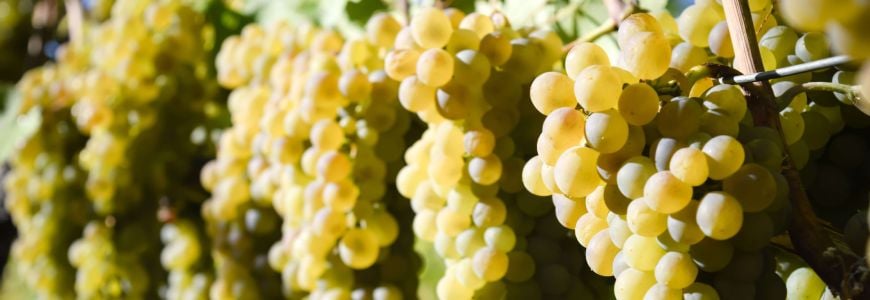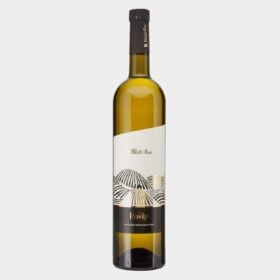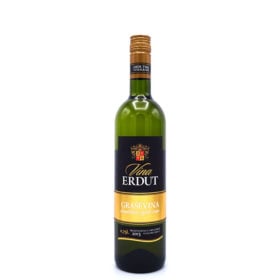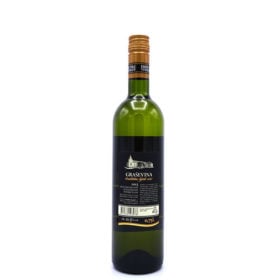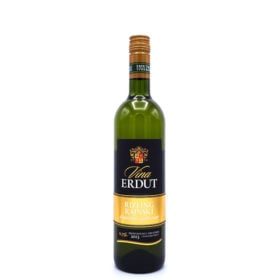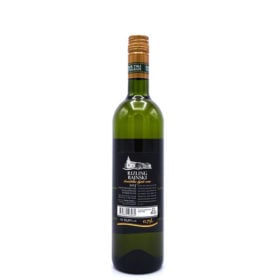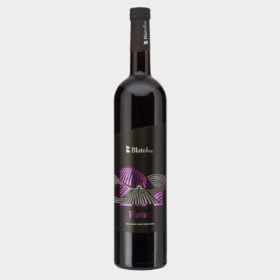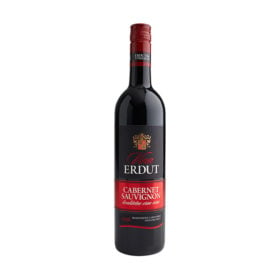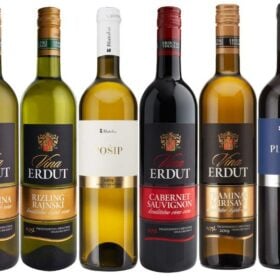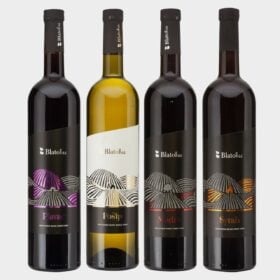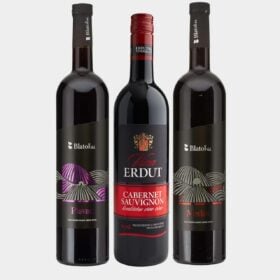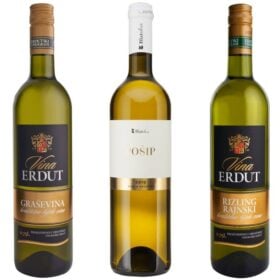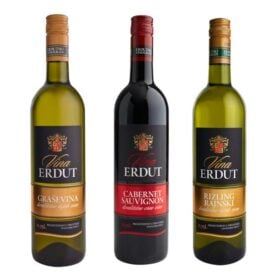The most popular white wines in Croatia are Posip, Graševina, grk, Vugava, Škrlet, Istarska Malvasia† And while some of the indigenous Croatian white wine varieties are listed below, there are many more, as there are estimated to be over 130 indigenous wine varieties in Croatia. But which of these white wines do you already know?
Posip
Posip is a native Croatian grape that was accidentally discovered on the island Korcula. Although grown in other Dalmatian regions, the grape is still widely cultivated on Korcula and achieves the best results in the vineyards around the villages of Smokvica and Čara.
The best versions of Posipvariety will be full and harmonious with a perfect balance between alcohol and acidity. They are usually golden yellow with fruity aromas of apricots, almonds, Mediterranean herbs, figs and citrus fruits. Posipwines pair perfectly with most Dalmatian dishes, especially fish and shellfish, while the oak-aged version pairs well with octopus or veal.
It also goes well with cheese and cured meat. Posip was the first white grape from Croatia with a protected geographical origin.
Graševina
Graševina is the Croatian name for a Central European variety of Welshriesling (also known as Laški Riesling , Olaszrizling , Riesling Italico) which is not native to the country but gives the best results in Croatia.
It is also the main Croatian grape for White wine, as it accounts for a quarter of all vines that are planted there. Graševina is characterized by pleasant, fruity and floral aromas, lively acidity, slightly bitter aftertaste, fullness and harmony.
The wines range from sparkling, dry (fresh, but also oak) to semi-sweet and late harvested pearls. These wines are very versatile, so it is possible to pair them with each course in one dinner.
Pinot Sivi / Pinot Grigio / Pinot gris
Pinot Sivi is the Croatian variant of the Pinot Grigio, also known as Pinot gris en Grauburgunder, is a white grape variety that is believed to have originated in Burgundy, but the grape has shown amazing potential in continental Croatia, as a result, this grape is mostly planted in the Croatian region of Slavonia and has produced great wines.
They are dense and concentrated, with typical notes of white flowers, honey, ginger, apricot, lemons, spices and dry fruit. The wines are usually dry with some off-dry varieties. They are usually full and go well with poultry, game birds and pork.
In the scent floral notes of blossom, white fruit of citrus and pear. A rich mouthfeel, full of ripe fruit notes, tropical fruits like notes of pineapple. With a richness of Mediterranean herbs. The finish is mineral, long and full.
Traminac / Gewürztraminer
Traminac is a Croatian name for another of the Central European favorites for White wine, the variety known in German as Gewürztraminer. The name of the variety comes from a name of a village in South Tyrol, the German-speaking part of northern Italy called Tramin, but unfortunately we can't really say where the variety originally came from.
It is a long and complicated genetic history, furthermore complicated by the fact that the genetics of this variety are extremely complicated and many wars have been fought in the region, and in the past this wine was simply called the Traminer, that name is late 19th changed to Gewürztraminer. “Gewürz” means spice or perfume, so it gives you an idea of what the wine actually is like.
During the long history of this grape in Europe it has been spread all over the continent, and much later also transferred to the new wine world. In Croatia, this wine is mainly made in the region Erdut and Ilok thanks to the good climatic conditions and the fertile soil along the Danube, this grape is doing well.
It is an extra-aromatic wine, with a bouquet of roses, lychees and passion fruit, and is sometimes called “the female wine” in Croatia. It can be drunk on its own, as an aperitif, but can also be combined with more fatty meals, such as foie gras, fine cheeses and fine desserts.
Isstarska Malvasia
Isstarska Malvasia is an indigenous Croatian white grape variety mainly grown in Istria, where it is mainly used in the production of varieties. These food-friendly wines are typically fresh and fruity, with mineral notes and aromas of green apple, acacia and apricot.
While most varieties are enjoyed young, some producers mature it for extended periods in oak, acacia vats or amphorae to produce slightly different expressions. Malvasia-wines go well with white fish, other types of seafood, but also with various dishes prepared with the white Istrian truffle.
except in Istria the grape is also grown in some parts of Slovenia and the Italian region of Friuli-Venezia Giulia.
Škrlet
Škrlet is considered a native Croatian white grape. Although its origins are still unknown, this late-ripening grape was first mentioned in writing in 1856. It is mainly grown in Pokuplje and Moslavina and gives best results on southern slopes that receive sufficient sun all year round. From Škrlet is usually made fresh and fresh young wine, characterized by its light yellow color with typical green hues.
It typically exhibits floral and fruity notes of green apples, pears and yellow plums, which complement the bright acidity. The wine goes well with light dishes such as freshwater fish, pasta or poultry-based main courses. Interestingly, the name of the grape comes from the German word scharlach (scarlet fever), due to the typical red dots that occasionally appear on the vine to show up.
Grek / Grk Bijeli
Grk or Grk bijeli is a native Croatian grape of the island Korcula which is mainly used in the production of dry white wines. The grape rarely gives a high yield and is mainly grown on sandy soils that surround the city of Lumbarda.
Since the name Grk translates as Greek, it was long believed that the grape had origins in Greece, but recent studies contradict this idea and state Crljenak Kaštelanski as the only one close to this rare and unique Croatian grape.
Also, the word g rk can be roughly translated as bitter – a subtle sourness is a common characteristic found in Grk wines. Most Grk wines are mineral and aromatic, with spicy nuances and a good balance between acidity and sugars. Interestingly, the Grk grape has only female functioning parts, which means it should be planted along with other grape varieties.
In Lumbarda it is usually used together with Plavac mali cultivated. Grk wines go well with white fish and shellfish, of course, but they can also go well with risottos, pasta dishes and aged cheese.
Maraština
Although it was assumed that Maraština is a native Croatian grape, research has shown that it is closely related to Malvasia del Chianti. Maraština is better known as Rukatac in some parts of Croatia. Nevertheless, this late-ripening grape is widely cultivated in the Croatian region Dalmatia, in particular the area around Šibenik and the islands of Hvar, Lastovo, Pelješac and Korcula.
Mararaština was mainly used as a blending grape to make it vintage wine, but has recently been proven to be an excellent grape in the production of varietal wines. These easy-drinking wines are usually fruity and fragrant with aromas of dry fruits and honey. They go well with white meat, seafood, fish, risottos and cheese.
The grape is also used in the production of Croatian dessert wine Prošek.
Muškat Momjanski
Muškat Momjanski is a wine of protected origin produced near Momjan in Istria. The wines are made from a Muscat variety, exactly a variety of Muscat Blanc à Petits Grains. The unique combination of microclimate and soil around Momjan turned out to be particularly suitable for the cultivation of Muscat.
It is believed that the grape was brought from Italy in the 1200s and adapted throughout history and acquired its distinctive character. The wines made in the region are rich and aromatic and can range from pale yellow to golden. The grape is used in the production of floral and fruity dry wines and more intense dessert wines, which usually show aromas of raisins, dry figs and honey.
These wines can also be labeled as archive wine (arhivsko vino) if they have been aged for at least five years. Muškat momjanskiwines are best served chilled. They can be enjoyed as an aperitif and go well with fruit desserts, especially pies, puddings and strudels.
Vugava
Vugava is a native Croatian grape that comes from a small island of Vis. Grown exclusively on the island, the variety ripens early in the warm Mediterranean climate and thrives on the terraced terroir around Komiža. on Vugava based wines are golden yellow, fresh and aromatic.
The acidity is typically low, the alcohol content is high and the wines will generally have a high sugar content. The aroma is reminiscent of ripe fruit, apricots, peaches and honey, sometimes with notes of citrus and spices. Vugava has a long history on the island and is believed to have been brought by the ancient Greeks.
Aside from varietals and white blends, the grape was also used in prošek – Dalmatian dessert wine made with dry berries. Vugava was rarely used in bulk wines. Although rare, it has always been known as a high-quality, premium Croatian grape. Vugavawines best match the local cuisine.
They go well with seafood, including shellfish and whitefish, but they also go well with poultry, salads, fresh fruit, and sheep or goat cheese.
Žlahtina
Žlahtina is an indigenous Croatian grape variety that is grown almost exclusively on the island of Krk, mainly around Vrbnik. The grape is used in the production of light and refreshing white wines intended to be enjoyed young.
They usually show floral and citrus aromas complemented by mineral notes and balanced acidity. Žlahtina goes well with sheep's cheese, fish and seafood dishes, but also with white meat and lamb. The name žlahtina comes from the Slavic word žlahten, which translates as precious or noble, possibly indicating the importance of the grape in ancient times.
Debit
Debit is a late-ripening white grape believed to be native to northernDalmatia. It is mainly used in everyday light varietal wines or as a blending grape, usually combined with other regional varieties. The best expressions of Debit come from the Promina and Drniš wine regions. At the beginning of the 20th century Debit a prized grape variety, but it slowly lost its prestigious status and by the early XNUMXs it was mainly produced with prolonged maceration, resulting in unimpressive and bland white wines.
In the mid-XNUMXs, several producers gave up on long-term maceration and began producing vibrant and aromatic white wines with bright acidity and a distinctive mineral character. Late harvest Debitgrapes are sometimes used in rich and concentrated dessert wines, while some producers even saw the grape's potential to produce exceptional sparkling wines. The grape is still believed to have originated in Croatia, although the alternative name Puljižanac — roughly translated as a person from Apuglia — might suggest Italian origins.
Debit wines go well with lamb or fish dishes.
Bratkovina Bijela
Bratkovina Bijela, sometimes too Bratkovina Called Blatska, it is considered an indigenous variety of the island Korcula. Although it is not yet possible to determine the exact origin of this grape, the fact that the spontaneous crossing of Bratkovina Bijela and Zlatarica Blatska resulted in Posip and that these three varieties are almost exclusively related to the island Korcula. These facts therefore support the assumption that the Bratkovina Bijela is from Korčla.
It is a fritte wine that is excellent with fish dishes and seafood such as the Dalmatian specialty brudet and other fish and shellfish, but also with vegetable and pasta dishes. Bratkovina Bijela will satisfy even the most refined wine lovers.
Zlatarica
Zlatarica is a true native Croatian grape variety. It is also known by the synonyms Zlatarica Bijela, Zlatarytza and Zlatharitza. According to DNA analyzes performed in 2002, it is a parent of the breed Posip. This wine should not be confused with the genetically different Zlatarica Vrgorska variety.
Zlatarica is an almost forgotten White wine from Croatia. But the latter is slowly becoming more popular and more famous. In recent years, the Zlatarica That's why it's made a kind of comeback. It's a fresh White wine and is sometimes mixed with other types of Croatian White wine.
It is a wine that goes well with shrimp, sushi and vegetable soup.
Malvasia Dubrovnik
It was long considered a local variety of the Dubrovnik region, but recent scientific research has shown that it is a member of a large Mediterranean Malvasia family, which
can also be found in several other countries such as Italy and Spain. In Croatia it has been proven to be one of the oldest varieties, since the name was mentioned in the 14th century documents from the Republic of Dubrovnik. its cultivation today has been limited to a narrow area of Dubrovnik and Konavli area. Due to its shape, with a loose cluster and thick grape skin, it is suitable for the production of traditional Prošek – sweet wine made from semi-dried grapes.
It easily builds up a high sugar content, so sweet wines from Malvasija are very sweet and very strong at the same time. Aromas are appealing, from honey notes, over candied citrus fruits, liqueur blends with dried figs and walnuts.
Kujundžuša
The origin of Kujundžuša is unknown, but is considered to be a local variety. According to tradition, it was named after a Turkish word (gold) describing the golden color of the grape in the ripe stage, and correspondingly after another, after the family name of Kujundžić, as one of its first producers. It is grown exclusively in the sub-region of Dalmatinska Zagora, around the town of Imotski.
Like Žlahtina it produces soft wines with milder acidity, so its mild character makes it easy to drink and very popular in its region of origin, where its vineyard representation is as high as 90%. The aroma is discreet, with: soft fruit traces mixed with mild ones minerals. A smooth taste, with alcohol ranging from 11% to 12% and not overly prominent acidity.
Riesling
Riesling (Rajnsky Riesling) is a variety that has been adapted to the chilly German climate for centuries and achieves best results in such or a similar climate. However, it is a fact that, as with Chardonnay, possesses the property of excellent adaptability to other totally different geoclimatic conditions.
In those parts of Croatia with a cooler climate, the resistance of the vine valued at low temperatures, which easily tolerates the increasingly rare occurrence of winter temperatures down to minus 20°C. Yield is moderate to high depending on several factors, mostly geographical.
A normal year under Croatian continental conditions can easily reach 10.000 liters per hectare. Riesling has the unique ability to achieve a high sugar content in ripe grapes while maintaining a very high acidity, often up to 15 grams per litre. Because of this trait and of course its refined aroma, it is an almost ideal variety for all types of predicates, and a late harvest would be a desirable minimum.
Three styles can be found in Croatia. One is a very light, refreshing and slightly sour wine, usually the result of the regular harvest time in the northern regions. From the western parts of continental Croatia it is light and refreshing, from the east it is mature and strong.
Sauvignon Blanc / Sauvignon Bijelis
Sauvignon is mainly grown in continental Croatia, where it is represented in all sub-regions, but it is also successfully grown in coastal Croatia, especially in Istria.
In continental regions it turns into wine on its own, without mixing with other varieties, in most cases it is intended for quick consumption, while a minority of better quality vinifies themselves in a way that requires shorter or longer maturation.
It rarely reaches wooden barrels (barriques), mostly in the Slavic sub-region, but even as such it shows interesting results as it successfully preserves the refreshing character of the aromas of gooseberry, freshly cut grass, elder and mineral notes, as well as freshness, juiciness and sweetness of the taste, the main anchor.
Croatian Sauvignon Blancs are often rich in elderberry scent.
Pušipel / Moslavac
Pušipel of Moslavac is a white grape variety grown in the northernmost Croatian region of Međimurje. It is an international grape that also occurs in Tokaji (Furmint), Slovenia (Šipon) and Austria (Mosler) in Hungary.
The grape is mainly used for dry white wines, but can also produce high-quality dessert and sparkling styles. Dry wines made from Pušipel are light yellow, mineral, fresh, light and easy to drink. They typically have fruity and citrus notes reminiscent of green apples, lemon and lime.
The acidity is moderate or high, while the alcohol content is generally low. These wines go well with different dishes. They can be combined with light bites and snacks or with heavier regional specialties. The first written record of Pušipel dates from the first half of the 19th century.
It was commonly called Moslavec or Šipon and its full potential was largely neglected. The grape rose to prominence with a branding strategy that emerged in the 2000s. Modern winemakers used the best vines, chose the name Pušipel and improved winemaking techniques Pušipel to be renamed as a flagship Međimurje grape capable of producing excellent quality wines.
Prč
Prč is a quality dry white wine from the vineyards of Hvar with a specific taste. It's a dry one White wine with characteristic taste produced from the rare, autochthonous muscadine grape variety Prč. It is produced in the middle of Dalmatia from the autochthonous Hvar Muscat cultivar in the place Sućuraj. It is a real island wine. The wine is golden yellow in color, has an intense, firm taste and specific nutmeg aromas.
The vinification starts with processing manually selected grapes in a pneumatic press under controlled fermentation and then in 16-18 degrees malolactic fermentation. Before bottling, this wine is often aged for a minimum of twelve months to obtain the specific taste aroma.
This White wine is ideal to combine with light dishes such as white meat and fish.
Cetinka
Cetinka is a native Croatian white variety. It is mainly grown on Korcula. It has a ripe truss is large to very large, weighing from 200 to 3000 g. The leaf of the Cetinka is pyramidal or conical with two to three hanging wings, has loose to compact, long and thick raceme stems.
The ripe berries are medium in size, round to ovoid, greenish yellow in color and amber on the sunny side. The skin is soft, opaque and has a juicy, sour flesh. The Cetinka is often grown on moist soil and gives high yields of average quality. It gives better quality in well exposed positions and warmer microclimatic conditions.
It generally thrives in all soil types, although it prefers fertile, warm and water-permeable soil. It is a variety of the Mediterranean climatic region.
The taste of the wine is light and refreshing and the color is greenish yellow. It contains about 12% alcohol and about 5 g/l of total tartaric acids. Resistance to powdery mildew and downy mildew is moderate and weak against Botrytis. The wine sausage also very often as vintage wine used to make blend wine.
Chardonnay
Chardonnay is naturally full and soft and has little acidity. This grape variety does not taste the same anywhere, even though it is grown all over the world. The grapes take on the flavors of the place where they grow. Yet there is a resemblance between all chardonnay wines. They always provide a soft feeling in your mouth.
It is an easy grape that is found all over the world. The grape variety easily adapts to the climate and soil where it grows. It is an early ripe grape that produces excellent results in both cool and warm conditions. The wines from a cool climate are fresh, apple-like and contain citrus fruits and high acidity. The warmer regions give a wine in which peach, melon, pineapple and citrus fruit predominate.
The strength of this grape variety is that it can produce beautiful wines in any climate. The style of chardonnayWine can therefore differ enormously per region: from nutty, heavy and fat to tingly fresh and slightly floral or exotic. Due to this diversity, this wine will never get boring. It always tastes different! Thanks to these special properties, it can be found in every wine country.
Jarbola
Jarbola is a real authentic Croatian white type of wine that can mainly be found in the Kvarner region. The mature leaf of this grape is medium in size. The cluster is medium in size, conical, compact. Ripe berries are medium in size, round, green-yellow in color. The petiole is medium long and greenish. The sticks are long, strong, hazelnut colored. The berries of the jarbola are short or medium length.
Thanks to extensive DNA analysis in 2003, it was established that the Jarbola is a real white Croatian grape variety. Until then it was an almost extinct white grape. DNA analysis showed that this is a unique variety and it is a real blessing that it was recognized in the old vineyards on the slopes of Ćićarija. Of the twenty found vines plant material was made, after which the grape gradually developed Istria and Kvarner scattered.
Jarbola gives good quality wines, full and fresh, with a high aromatic potential and suitable for pairing. It is refreshing, has a light yellow color through which the green tint passes, and a fruity floral scent with pronounced green apple components. Wine is made from the grapes that is very similar to a quality wine.
And what about red wines?
Do you think White wine not tasty? No problem! The Croatian Red wine has a long and rich tradition dating back to the ancient Greek settlers who planted vineyards along the Dalmatian coast. The Roman Empire later took over and expanded these vineyards, and some of Croatia's finest wines are said to have been drunk by none other than Emperor Diocletian himself.
Today, Croatian wines are experiencing something of a renaissance as more and more people discover the delicious red wines this beautiful country has to offer.
There are many different varieties in Croatia Red wine produced, ranging from light and fruity to full and robust. Some of the most popular types are Plavac Mali, Cabernet Sauvignon, Blaufränkisch / Frankovka, Merlot, Teran en Zinfandel.
- Original price was: 19,98. 13,99Current price is: 13,99. Add to Cart

